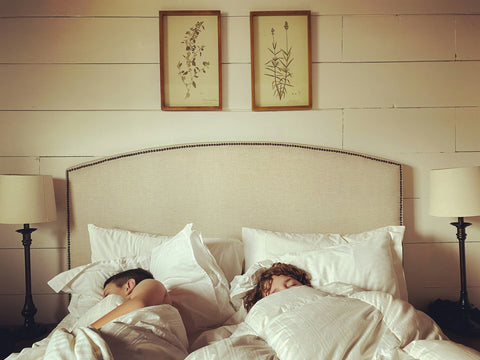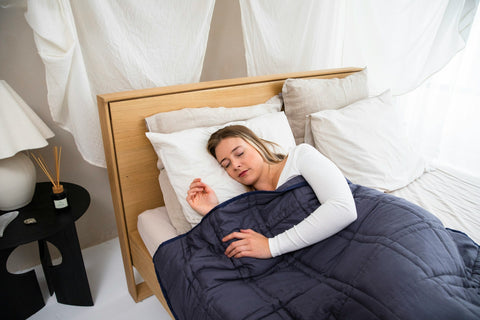
Nothing is like snuggling under a fluffy down comforter when the temperature drops. These cloud-like bed covers trap warmth while still allowing for breathability, ensuring you won't wake up sweaty in the middle of the night. Not all down comforters are equal; choosing the wrong one can ruin your sleep. If you've been wondering how to choose the best duvet insert comforter that offers the perfect balance of warmth, comfort, and durability, you're in the right place. This article will help you sift through the options to find one you can cozy up with for years to come.
Yumerest's cloud-like fluffy duvets help you achieve your goal of restful sleep. Our duvets offer the benefits of the down comforter without the drawbacks, ensuring cozy, restful sleep for years to come
What Are the Benefits of a Down Comforter?

Down comforters, also known as down duvets and down duvet inserts, are made with clusters of down feathers (Down feathers are the soft undercoating of geese and ducks. They’re found closest to the bird’s skin and act as a layer of insulation underneath the tough outer feathers.
Because down feathers are light, fluffy filaments free of hard quills, they’re a popular choice for high-quality clothes and luxury bedding. They’re known for being incredibly soft because of their loft or fill power, which is the amount of down in one ounce. The fill power of a down comforter ranges anywhere between 550 to 800.
Fill Power
The higher the fill power, the higher the quality of the down comforter. Our Luxury White Goose Down Duvet has 650 fill power that gives you the best quality and is lightweight and offers customizable warmth year-round.
The Benefits of a Down Comforter
Not only do down comforters provide a cloud-like sleeping experience, but they also come with several other perks.
Extremely soft
There’s no comparison to the comfy feel of a comforter filled with down feathers. The quality of the down feathers will affect the softness, so you’ll want to pick a top-notch comforter from a well-trusted brand.
Insulated but breathable
Comforters filled with down feathers give you the best of both worlds. In colder months, they provide warm, snuggly bedding with a layer of insulation. They're also light and breathable, since the down feathers allow more air and moisture vapor to flow through the comforter. So, they can also be used when the weather warms up.
Durable
A down comforter can last up to 10 to 15 years when properly cared for. However, they are a hassle to wash, so you'll want to either spot-clean them or have them professionally cleaned.
Compressible
Because of their high fill power, down comforters are easily folded into a much smaller size than alternative comforters. This compressibility makes them a great option if you have limited space to store your bedding.
What are the Drawbacks of a Down Comforter?
Down comforters also have disadvantages, so you’ll want to consider the big picture and see if a down alternative comforter would better fit your home.
Allergies
Some people are allergic to the dust particles found on down feathers. While a hypoallergenic down comforter is available, it will be more expensive. Naturally, hypogenic synthetic down comforters provide a safe alternative if you've reacted badly to down bedding.
Cleaning
Down comforters are much harder to clean than their alternatives. If you want something lower-maintenance, consider a synthetic down comforter instead. Otherwise, toss your down comforter into a front-loading dryer every few months and put the settings on air or low. This will help keep:
-
The moisture down
-
The softness up
Have your down comforter professionally laundered to maintain its optimal fluff. Find some middle ground and protect your down comforter with a duvet cover that you can remove and wash easily.
Price
Because the down is from waterfowl, it's more expensive than other comforters. While they are more durable (translating to a more affordable cost per wear), down comforters require a higher upfront investment.
Related Reading
How to Choose a Down Comforter That’s Perfect for All Seasons

Before choosing a down comforter, you should consider a few aspects first. Otherwise, you may not receive the right comfort level from the first comforter you bought off the shelf.
Important Aspects
Some factors include:
-
Knowing the difference between goose and duck down
-
The right warmth level
-
The different weaves
-
How to find the best size
Research beforehand is an extra step, but it can help you find the best down comforter.
Goose vs. Duck Down: What’s the Difference?
Down comforters contain either goose or duck down. Goose down contains larger down clusters and traps more heat. This is why goose down comforters are so popular that they’re more expensive than duck down.
Duck down has smaller clusters and provides less insulation, but duck down comforters cost less than goose down. Duck down is an excellent choice for those:
-
On a budget
-
Looking for a down comforter
Warmth Level: How Warm Do You Want Your Comforter?
One major component that can influence which comforter you choose is the warmth level you’re looking for. Is the comforter for cold weather, warm seasons, or year-round use? To find the right warmth level, look at a potential comforter’s:
-
Fill power
-
Fill weight
These two aspects influence how much warmth a comforter has.
Fill Power: Is Bigger Really Better?
Fill power is defined by how much material is contained inside one ounce of fabric, and is measured in grams per square meter (GSM). The higher the fill power, the more insulation a down comforter offers. Most comforter brands list the GSM in the product description or specifications.
If you’re looking for a spring or summer comforter, the fill power should be 400GSM or less. For a cold-weather comforter, 600GSM or higher. Then, if you want to enjoy a year-round comforter, the fill power should be between 400GSM AND 600GSM.
Fill Weight: How Much Does It Weigh?
Fill weight refers to the number of ounces inside a comforter. Fill weight is the driving force behind how much warmth a comforter has. The higher the fill weight, the warmer the comforter.
Shell Material: What’s the Comforter Made Of?
The outer material that encases the fill is the down comforter’s shell. Shells can come in various fabrics, but the two most common are:
-
Cotton
-
Silk
Some brands may have cotton-blend or polyester shells, but these materials are typically found in down alternative comforters.
Cotton Benefits
Cotton is a natural material known for its:
-
Breathability
-
Softness
It’s also one of the most popular bedding materials. Many all-season down comforters have cotton shells because the material keeps you warm, but maintains continuous airflow. Cotton keeps you:
-
Warm and cozy in the winter
-
Cool during the summer
Silk Option
Silk is another natural material used in comforter shells. Silk is a breathable, wrinkle-resistant, and notably strong fiber. The material is also more expensive, but the smooth and shiny material may be worth it if you prefer silk.
Stitching: How Is It Put Together?
How the comforter is stitched affects not just the blanket’s appearance, but how the fill is distributed. Stitching prevents fill from clumping in one area so that you can enjoy a soft, even surface. Filling that bunches up in a specific section doesn’t give you balanced warmth.
One side of the bed may feel warmer than the other. Down comforters have one of four basic stitchings:
-
Baffle box
-
Gusseted
-
Sewn through
-
Diamond quilt
Stitching Styles
In a baffle-box construction, an extra piece of material is sewn between the front and back sides in a uniform pattern. Baffle box stitching creates a checkerboard pattern with 3D boxes. Many comforters meant for cold climates have a baffle box design.
With gusseted stitching, an extra strip of fabric is used to connect the front and back sides. Gusseted stitches create more loft in a comforter when filled. The filling expands upward instead of outward.
Stitching Methods
Sewn-through stitching is similar to the baffle box. The front and back sides are sewn together without the extra strip of material, creating a 2D box with less fill.
Diamond quilt stitching has two parallel lines, creating a diamond-shaped pattern. This type of stitch:
-
Creates compartments for filling
-
Prevents clumping
Weave: How Does It Feel?
Weave refers to how the shell material is woven and can determine how a comforter feels. Weave also affects a comforter’s breathability. There are two common types of weave:
-
Sateen
Percale is a close-knit weave containing thinner threads. Compared to the denser sateen weave, this plain weave has a crisp, lightweight feel, providing a cooler sleep. Sateen uses thicker threads in its weave, producing a heavier material with a silk-like sheen.
Sateen Weave
The sateen weave is also breathable but is warmer than percale. If you prefer smoother material, sateen is your best option.
Thread Count: What’s the Number?
Thread count refers to how many fibers are woven to create one square inch of fabric. Thread count ranges from 250 to over 1,000, but beware of any bedding material with a thread count of more than 800. Most materials with higher thread count are not durable.
It’s impossible to fit that many single-ply threads in one square inch. Some bedding manufacturers separate single-ply fibers and twist them together, creating multi-ply fibers. Instead of counting the single-ply fiber as one thread, they count each fiber, boost thread count, and make a down comforter seem more luxurious than it is.
Thread Count
You may notice some down comforters have higher prices because the thread count is higher. Separating a single-ply fiber makes the thread weaker. A high thread count comforter may only last a few years compared to a comforter with a thread count under 800.
If you’re looking for an all-season down comforter, the thread count “sweet spot” you should look for is between 300 to 500. A comforter with 500 to 700 thread count is excellent for cold-weather down comforters.
Comforter Size: How Big Should It Be?
When finding the right comforter size, you may notice that the dimensions are not exact when comparing several down comforters of the same size. Some may appear longer or shorter than others. That’s because bedding manufacturers add or remove inches to adjust how a comfort drapes over the side of the bed.
You want a down comforter to drape over the mattress, fully covering the bed’s sides. The best way to find the right-sized comforter is to measure how thick your mattress is and add those inches to each side of the bed’s measurements.
Size Guide
A queen-size mattress is 60 inches wide and 80 inches long. If your bed is 12 inches thick, you would add 12 to each side, so your comforter should be at least 72 inches wide and 92 inches long.
Seasonal vs. Year-Round: How Will You Use It?
Not all comforters are built for year-round use. Some bedding companies create comforters meant for specific seasons. Manufacturers usually specify if a particular comforter is for warm or cold climates. Check out the product description to determine if a potential comforter is for seasonal or year-round use.
Maintenance: How Do You Clean It?
Remember that most down comforters are dry cleaned only because down feathers contain natural oils. These oils keep feathers nice and fluffy. Chemicals from laundry detergent strip the down feathers of these oils, causing the down comforter to go flat.
Dry cleaners use special solvents, effectively cleaning your comforter without damaging the material. If you purchase one that's machine washable, wash it in a front-loading washing machine on a gentle cycle. Add an extra rinse to ensure you're removing all the detergent. When drying, use dryer balls to help fluff.
Care Tips
If the dryer seems stuffed full, take breaks throughout the drying cycle to shake out and fluff the comforter. Look at the care instructions to determine how to maintain your down comforter. Following these guidelines helps the comforter to last for years to come. Adding a duvet cover is another way to help your down comforter last.
Many down comforter brands have built-in corner tabs to secure the comforter inside a duvet cover. Duvet covers protect your down comforter from stains. In case of an accident, simply remove the duvet cover and place it in the washing machine for easy cleanup.
Warranty: What Happens If It’s Defective?
A warranty reassures customers of a sound purchase. Enjoy your down comforter fully without replacing it because of premature manufacturing defects. These defects include:
-
Loose seams
-
Small tears
The warranty allows you to exchange the faulty comforter for repairs or a replacement in case of a defect. Most comforter warranties last about a year, though some may last longer, depending on the brand.
Down vs. Down Alternative: What’s the Difference?
Down is the soft fluff underneath a bird’s exterior feathers. Birds rely on down for insulation. These fluffy clusters don’t have sharp quills, and down is a popular fill material for comforters. Down provides the ultimate softness without painful quills poking through the material. Down clusters are also light and breathable, so you feel warm and cozy without overheating.
Down alternative fill mimics the feel of down. Down alternative comforters usually contain synthetic materials, like polyester. They are soft but may not be as plush as down. Other down alternatives include:
-
Rayon
-
Cotton
Unlike down, down alternative comforters are hypoallergenic. The materials are less likely to attract dust mites and other allergens, making down alternatives the better option for those with allergies. You’re less likely to experience allergic reactions at night with a down alternative comforter.
Related Reading
- Best Comforter Material for Hot Sleepers
- Best Duvet Cover Material
- Best Comforter for Allergies
- Duvet Tog Guide
- Best Duvet for Night Sweats
Get Deep Sleep Every Night with Our Cloud-like Soft Fluffy Duvets

Yumerest's PureFlow Duvet transforms your bedroom into a luxurious sanctuary, enveloping you in cloud-like softness with its exceptional 5kg filling that promotes deeper, more restorative sleep.
This premium Canadian duvet stands apart from competitors like Happy Fluffy Cloud and Hush through its ethically sourced northern down that perfectly regulates temperature year-round. It’s never too hot, just perfectly cozy.
Expert Craftsmanship
Crafted by expert artisans with techniques perfected since 1946, our duvets combine traditional craftsmanship with modern innovation for an unparalleled sleeping experience.
The PureFlow bundle, featuring our heavenly duvet, elegant cover, and calming sleep mist, creates a complete sleep sanctuary that helps busy professionals and parents finally achieve the rejuvenating rest they deserve. Get deep sleep every night with our cloud-like fluffy duvets.







